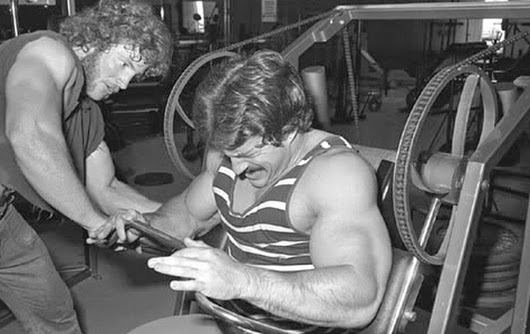The big misconception about weight training: Does it increase aerobic fitness?
Of all the misconceptions about strength training and weight lifting, one that comes up a lot is that they have no aerobic component. Therefore, the idea goes, if you do only weight training, you won’t build sufficient cardiorespiratory fitness, which you need to protect your heart and get the benefits of exercise. But weight lifting increases aerobic fitness, all on its own.
On at least two occasions, when a doctor has asked me what I do for exercise — after remarking that I was in great shape — and I told them weight lifting, they said I needed to add some aerobic exercise (cardio).
It’s obvious that these doctors never lifted weights. At my weight lifting sessions, I have to catch my breath after a set and my heart is often going at around 160 to 180 beats per minute.
It’s not just a couple doctors either. The view is widespread that you must do a very special form of exercise, called aerobics or cardio, to improve heart and lung function and raise VO2max, the most common measure of cardiorespiratory fitness.
On the contrary, weight lifting raises VO2max.
How much does weight lifting increase VO2max?
A review article looked at every study they could find on the relation between resistance training and VO2max: “Resistance training induced increase in VO2max in young and older subjects”.(1)
What they found was that the improvement in VO2 max caused by resistance training depended on the initial VO2max of the participants. See the following graph:

If the participants had a generally low VO2max initially, then they improved. But if they had generally good VO2max initially, no improvement was seen.
Now, take a look at the following chart of VO2max norms, for men, by age. (Chart from here.)

You can see that the VO2max level to which resistance training will get you (first chart) ranks from good to excellent for all age groups of men.
The studies that the reviewers compiled had great variation in number of sets, rest times between sets, and frequency of training.
How to increase the cardiorespiratory component of your weight training
Generally, the less time between sets, the greater the cardiorespiratory workout. So if increasing cardiorespiratory fitness is among your goals, take short rests between sets. A circuit-training scheme with short rests should be ideal for increasing fitness.
The caveat here is that if you are a trained runner or similar athlete, weight training won’t do much extra for your fitness level. Elite marathon runners, for example, have a VO2max in the upper 60s to 70s or even higher. Lance Armstrong clocked in at 84.0. It’s unlikely that weight training would increase his fitness.
As for other benefits that are ascribed to aerobic conditioning, weight training can do these too. For instance, artery diameter in young men increased in response to weight training.(2)
Blood flow in the legs in resistance-trained men aged 35 to 65 was not different from that of young resistance-trained men, while sedentary men aged 35 to 65 had only 30% as much leg blood flow as the young men.(3) Therefore resistance training looks to be a powerful way to keep the circulation young and healthy.
The moral of this story is that if you lift weights regularly and especially with intensity, then you probably don’t need to add cardio to your regimen to obtain good cardiorespiratory fitness.














17 Comments
Powerfully increasing one’s aerobic fitness is actually quickly done with mere minutes
of effort per day (when one lacks a gym or lifting equipment):
By doing Burpees.
Do it like that fellow:
https://www.youtube.com/watch?v=c_Dq_NCzj8M
Now, there are a lot of advantages with these.
Much alike HIT training in lifting weights,
HIT training is also possible for increasing endurance, by basically doing for a shorter
amount of time the maximum one is able to put out.
There are many regimes, like sprint training etc., and they all work as well
as long-time (30+ minutes) endurance training like jogging, in increasing endurance, proven by a lot of studies.
A disadvantage is that it is more taxing, takes more willpower, more effort than just
jogging along at lower effort for a much longer time.
But if you want to significantly improve your endurance without investing much time,
this one is for you.
Burpees are so good because you need nothing else to do them than a bit of ground to stand on
and few minutes of time.
Burpees are not only an extremely valuable training method, they are also very useful
as a quick and precise measurement method for determining how good or bad a person’s endurance level
actually is without needing complex instruments or much time (Mr. Burpee, a military physician, actually
invented them for this purpose):
World-class athletes manage 100 Burpees in seven minutes;
taking less than 10 minutes for them is considered good.
For training, Burpees can be done about anytime and everywhere, you know, just like
HERE AND NOW.
When studying or working, I like to do 20 or 30 Burpees once per hour to keep my metabolism up
and train a little (it also greatly helps concentration, wakefulness etc. when you take just a minute
each hour to keep the blood flowing this way – it’s just a great tool for mental work or when you
need to become alert and awake quickly after waking up).
If you want to become (self-)competitive about it, try to do 100 Burpees as quickly as possible;
train daily or every other day, and soon you will see your results, endurance and general feeling well
increasing by a lot!
Garrett, I agree with you. High intensity interval training , including burpees, is a great, kick-ass way to get in shape. I wrote about this in my book, but I also should have included a link here to my post on it: High-intensity training: Why you should do it..
I think it is very important for most people to keep things as simple as possible while keeping it also as effective as possible – what is needed is efficiency.
There is a lot of training schedules, advice and “systems” out there, and people who know not much but want to do something that works are often overwhelmed with all the information and end up doing nothing or wasting their time with nonsense that costs money and time and gives no real results.
Whole industries are built around such bad advice, because just giving people information that works
cannot provide a constant income stream – this is best witnessed in womens’ or sports magazines and diets – new, fashionable nonsense advice and “research” week after week is given out that does not work well or not at all, because, of course, if people become slim and strong they would stop buying the magazines and then
the profits are gone.
That is the beauty in Burpees – they are simple, they are free, they need no gear, they are highly effective and they are equally suitable for beginners and professionals, house wives and elite athletes. I know of nothing else that combines so many good qualities.
If you are doing circuit training then you probably aren’t doing heavy lifting. If you want to build serious strength, it helps to do barbell lifts, and those require recovery between heavy sets. I guess where I differ from you is that I consider HIIT to be “cardio”. A combination of weight lifting and some type of HIIT would be ideal, I think.
By the way, this piece gives a nice overview of the various aspects of fitness improved by lifting weights:
https://startingstrength.com/article/strength_fitness
On weight training not being “cardio” or “aerobic” enough, a personal observation:
I go do 5×5 heavy squats, and I’m gasping for breath when it’s all done. Meanwhile, other gym clients are moseying on the treadmill and having full conversations, at normal pace, normal volume.
And they remark at my weight loss, simultaneously wondering why they make no progress.
I am always gassed and drenched in sweat after a couple sets of squats or deadlifts. It still amazes me that it happens that quickly.
I’ve noticed the same thing. I sweat more, and earlier, when I lift than when I used to do cardio (it usually took 6 – 8 minutes to break into a sweat).
If your heart rate isn’t “in the zone” when you lift, you’re doing it wrong.
Put down the colorful plastic 5lb weights, ya pussy!
I’m stealing that.
Hey! I sometimes use 5# weights.
(For jumping jacks.)
Fitness is health but fitness shouldn’t be measured by markers like VO2 max, BP, body fat etc. The bench mark of fitness is work capacity across different tasks…fast slow heavy light. Lance Armstrong was a great cyclist with huge vo2 max but probably sacraficed upper body pressing power. The trick with true firness and health is to not engage in exercise that results in sacraficing one domain for another.
If you have not read about Arthur Jones’ West Point Experiment w/HIT (not HIIT–intervals were avoided to the extent possible) AKA Project Total Conditioning and its effect on “unrelated” measures of fitness, such as a two-mile run, you might enjoy:
https://arthurjonesexercise.com/Athletic/Total.PDF
(It was speculated that the result on bf testing was the result of different people taking the before & after measurements)
Thanks, Daniel, I’ll be reading that closely. Jones sure pops up in a lot of fitness contexts.
I know from personal experience that weight lifting increases aerobic fitness. There was a time when I was so out of shape I would see stars in my vision after lifting something heavy or simply bending and overexerting the wrong direction. When I began lifting weights, all aspects of my aerobic fitness increased. My blood flow is even better. My back and neck don’t hurt anymore as well as I believe lifting weights is good for the spine and other bones and joints if done correctly.